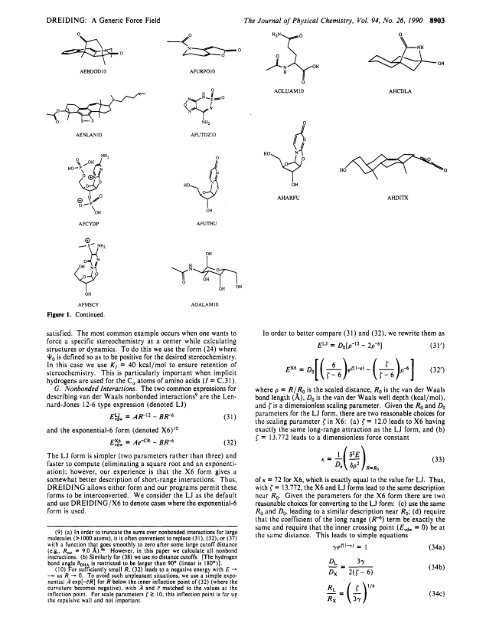DREIDING: A Generic Force Field for Molecular Simulations
DREIDING: A Generic Force Field for Molecular Simulations
DREIDING: A Generic Force Field for Molecular Simulations
Create successful ePaper yourself
Turn your PDF publications into a flip-book with our unique Google optimized e-Paper software.
<strong>DREIDING</strong>: A <strong>Generic</strong> <strong>Force</strong> <strong>Field</strong> The Journal of Physical Chemistry, Vol. 94, No. 26, 1990 8903<br />
AEBDOD 10<br />
AFUWOIO<br />
0<br />
HzN-Yo<br />
$yOH<br />
0<br />
AENLANIO<br />
I<br />
NH2<br />
0<br />
AFUTDZIO<br />
0<br />
AGLUAM 10<br />
"od<br />
0<br />
AHCDLA<br />
HO -0<br />
bH<br />
' 0<br />
0 ?/<br />
0 -P<br />
'OH<br />
OH<br />
AHARFU<br />
AHDITX<br />
AFCYDP<br />
AFUTHU<br />
-Y2<br />
@/<br />
(jl<br />
0<br />
OH<br />
AFMSCY<br />
Figure 1. Continued.<br />
OH<br />
I<br />
AGALAM 10<br />
OH<br />
OH<br />
satisfied. The most common example occurs when one wants to<br />
<strong>for</strong>ce a specific stereochemistry at a center while calculating<br />
structures or dynamics. To do this we use the <strong>for</strong>m (24) where<br />
q0 is defined so as to be positive <strong>for</strong> the desired stereochemistry.<br />
In this case we use K, = 40 kcal/mol to ensure retention of<br />
stereochemistry. This is particularly important when implicit<br />
hydrogens are used <strong>for</strong> the C, atoms of amino acids ( I = C-31).<br />
G. Nonbonded Interactions. The two common expressions <strong>for</strong><br />
describing van der Waals nonbonded interactions9 are the Lennard-Jones<br />
12-6 type expression (denoted LJ)<br />
~ : = d A~<br />
R~Z - BR-6<br />
and the exponential-6 <strong>for</strong>m (denoted X6)I0<br />
E$$ = AeXR - BR-6<br />
(31)<br />
(32)<br />
The LJ <strong>for</strong>m is simpler (two parameters rather than three) and<br />
faster to compute (eliminating a square root and an exponentiation);<br />
however, our experience is that the X6 <strong>for</strong>m gives a<br />
somewhat better description of short-range interactions. Thus,<br />
<strong>DREIDING</strong> allows either <strong>for</strong>m and our programs permit these<br />
<strong>for</strong>ms to be interconverted. We consider the LJ as the default<br />
and use <strong>DREIDING</strong>/X6 to denote cases where the exponential-6<br />
<strong>for</strong>m is used.<br />
(9)(a) In order to truncate the sums over nonbonded interactions <strong>for</strong> large<br />
molecules (>IO00 atoms), it is often convenient to replace (31), (32), or (37)<br />
with a function that oes smoothly to zero after some large cutoff distance<br />
(e&, R,", = 9.0 A)?. However, in this paper we calculate all nonbond<br />
Interactions. (b) Similarly <strong>for</strong> (38) we use no distance cutoffs. [The hydrogen<br />
bond angle is restricted to be larger than 90° (linear is 180')).<br />
(IO) For sufficiently small R, (32) leads to a negative energy with E -<br />
--m as R - 0. To avoid such unpleasant situations, we use a simple exponential<br />
2 exp[-S'R] <strong>for</strong> R below the inner inflection pint of (32) (where the<br />
curvature becomes negative), with 2 and S' matched to the values at the<br />
inflection point. For scale parameters .t 2 IO. this inflection point is far up<br />
thc repulsive wall and not important.<br />
In order to better compare (31) and (32), we rewrite them as<br />
ELJ = Do[p-12 - 2p-61<br />
(31')<br />
where p = R/Ro is the scaled distance, Ro is the van der Waals<br />
bond length (A), Do is the van der Waals well depth (kcal/mol),<br />
and {is a dimensionless scaling parameter. Given the Ro and Do<br />
paramcters <strong>for</strong> the LJ <strong>for</strong>m, there are two reasonable choices <strong>for</strong><br />
thc scaling parameter f in X6: (a) { = 12.0 leads to X6 having<br />
exactly the same long-range attraction as the LJ <strong>for</strong>m, and (b)<br />
f = 13.772 leads to a dimensionless <strong>for</strong>ce constant<br />
(33)<br />
of K = 72 <strong>for</strong> X6, which is exactly equal to the value <strong>for</strong> LJ. Thus,<br />
with f = 13.772, the X6 and LJ <strong>for</strong>ms lead to the same description<br />
ncar Ro. Given the parameters <strong>for</strong> the X6 <strong>for</strong>m there are two<br />
reasonabk choiccs <strong>for</strong> converting to the LJ <strong>for</strong>m: (c) use the same<br />
Ro and Do. leading to a similar description near R,; (d) require<br />
that thc coefficient of the long range (R") term be exactly the<br />
samc and require that the inner crossing point (Evdw = 0) be at<br />
thc samc distancc. This leads to simple equations<br />
yeT(l-') = 1 (344<br />
(34c)
















